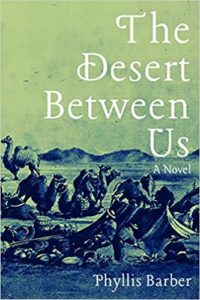 Phyllis Barber, a past winner of the Smith-Pettit Foundation Award for Outstanding Contribution to Mormon Letters, introduces her new novel, The Desert Between Us, which will be published be the University of Nevada Press in April.
Phyllis Barber, a past winner of the Smith-Pettit Foundation Award for Outstanding Contribution to Mormon Letters, introduces her new novel, The Desert Between Us, which will be published be the University of Nevada Press in April.
The seed for The Deseret Between Us was definitely planted when I heard there had been camels in the Southwest. Camels. In the Southwest of the United States. I had never heard of them before that first hint, but my curiosity was affected big-time. And then I read about a camel sighting in St. Thomas, Nevada, in the early days. And another in 1950 somewhere in Texas.
Camels. Camels. I had to know more.
According to the catalogue of The University of Nevada Press, “The Desert Between Us is a sweeping, multi-layered novel based on the U.S. government’s decision to open more routes to California during the Gold Rush. To help navigate this waterless, largely unexplored territory, the War Department imported seventy-five camels from the Middle East to help traverse the brutal terrain that was murderous on other livestock.”
In the novel, after the road has been explored and surveyed, one of the roadbuilders, Geoffrey Scott, the son of an abolitionist and a man determined not to wear a military uniform, ventures north to St. Thomas—a Mormon polygamous community in 1865-70. (This settlement was first located in Utah Territory, then, as the government rather than Brigham Young decided on boundaries, became a part of Arizona Territory. After 1866, when surveyors were sent to the area, the community was told it now belonged in the newly-formed state of Nevada. The state demanded taxes be paid in gold and silver. No luck in this agrarian community, and the original settlers, under the direction of The First Presidency of The Church of Jesus Christ of Latter-day Saints, voted to disband.)
Accompanied to St. Thomas by a camel he names Adababa and a Mojave Indian, Geoffrey Scott falls in love with the third wife of a polygamist yet doesn’t understand Sophia Hughes’ deep faith in the Mormon religion. Even though Sophia has a very short-lived illicit relationship with Geoffrey and wonders why her husband Charles can have several wives and she can’t have several husbands, she is tormented by the life-changing decisions she must make. And thus the dramatic hook of the novel.
 In real life, besides camels catching my attention, some of my ancestors were called by Brigham Young to settle St. Thomas and to practice polygamy there. One was said to be ill-tempered, so one of my characters is based on that information. Writing about an ill-tempered polygamist was an exercise in boldness, I must say, but the LDS rules of behavior were just beginning to be formulated at the time which gave me greater license. To make matters more interesting, I grew up in Boulder City and Las Vegas, Nevada, both about ninety miles from St. Thomas, which was buried underwater by Lake Mead (formed by the Hoover Dam) when I was a young girl. Today, the lake has shrunk, the foundations are clear and evident, and the site can be visited on a mile hike, hopefully on a cloudy day. The temperatures can be unmerciful.
In real life, besides camels catching my attention, some of my ancestors were called by Brigham Young to settle St. Thomas and to practice polygamy there. One was said to be ill-tempered, so one of my characters is based on that information. Writing about an ill-tempered polygamist was an exercise in boldness, I must say, but the LDS rules of behavior were just beginning to be formulated at the time which gave me greater license. To make matters more interesting, I grew up in Boulder City and Las Vegas, Nevada, both about ninety miles from St. Thomas, which was buried underwater by Lake Mead (formed by the Hoover Dam) when I was a young girl. Today, the lake has shrunk, the foundations are clear and evident, and the site can be visited on a mile hike, hopefully on a cloudy day. The temperatures can be unmerciful.
The research for this novel involved much reading and research, but the most pertinent sources were the journals of May Humphreys Stacey, supplemented by the report of Edward Fitzgerald Beale and printed by Harvard College and the Huntington Library Press. Beale also wrote a letter to the Secretary of War relating to the construction of a wagon road from Fort Smith to the Colorado River. I also relied on Forrest B. Johnson’s The Last Camel Charge, Arabell Lee Hafner’s 100 Years on the Muddy, and Aaron McArthur’s St. Thomas: A History Uncovered, among many other books written about the period and the geography.
I made an effort to stay faithful to historical outlines, but I also wanted to write a novel about people planted both willingly and unwillingly in this area of the world, trying to build a settlement, trying to remain true to the beliefs they’d been taught. In other words, this is a story about real, rather than idealized, people attempting to live on the edge of a sword, some doing so with admirable grace.
 Phyllis Barber is a writer living in Park City, Utah. She writes about the West, the desert, the Mormons who played a significant role in settling the West and creating the person she’s become, and about matters of the spirit with its familiar and unfamiliar reaches. She’s been writing award-winning stories, articles, essays, and books for over thirty-five years, in between being the mother of four sons, teaching creative writing, riding her bicycle, traveling the world, reading a wide spectrum of books, and serving as a community volunteer. Her previous books include the short story collections The School of Love (1990) and Parting the Veil: Stories from a Mormon Imagination (1999), the novel And the Desert Shall Blossom (1991), the children’s book Legs: The Story of a Giraffe (1991) and the memoirs How I Got Cultured: A Nevada Memoir (1992-AML Award winner), Raw Edges: A Memoir (2010), and To The Mountain: One Mormon Woman’s Search For Spirit (2014).
Phyllis Barber is a writer living in Park City, Utah. She writes about the West, the desert, the Mormons who played a significant role in settling the West and creating the person she’s become, and about matters of the spirit with its familiar and unfamiliar reaches. She’s been writing award-winning stories, articles, essays, and books for over thirty-five years, in between being the mother of four sons, teaching creative writing, riding her bicycle, traveling the world, reading a wide spectrum of books, and serving as a community volunteer. Her previous books include the short story collections The School of Love (1990) and Parting the Veil: Stories from a Mormon Imagination (1999), the novel And the Desert Shall Blossom (1991), the children’s book Legs: The Story of a Giraffe (1991) and the memoirs How I Got Cultured: A Nevada Memoir (1992-AML Award winner), Raw Edges: A Memoir (2010), and To The Mountain: One Mormon Woman’s Search For Spirit (2014).
